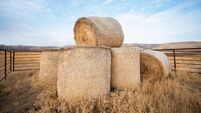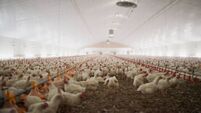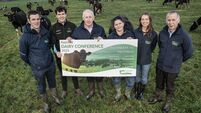Precision technology with the potential to reduce fertiliser use by 25%

A stand demonstrates how traditional, linear style sowing of fertiliser at seeding leaves a significant proportion of fertiliser in an unused area between plants.
Environmental concerns are central to most of Kverneland's innovations this year.
The Pudama – a seed and fertiliser sowing combination – which is capable of reducing the volume of fertiliser used when sowing maize by as much as 25% - was also among the line-up on show this year.
The impressive 25% reduction figure has now been verified by independent studies conducted at research institutions across Europe, and is achieved by the precision placement of fertiliser only within a 10cm radius of the seeds rather than continuous linear application as is typical in other seeders.
Furthermore, the direction of new European rules to increase the width between rows of crops mean that the fertiliser savings could be even greater as the greater distance between crops means more fertiliser is left in the zone between seeds where nutrients are not taken up by the plants.
At this point, the benefits of the machine are currently only realised in crop such as maize, however, Kverneland engineers are working to develop a solution also suitable for cereal crops like wheat and barley.

“There is a further benefit if I am using 25% less fertiliser in drilling, then there is also less workload demand in terms of refilling the machine, and I can do more acreage,” a spokesman said.
“We estimate it saves 50kg of fertiliser for every hectare. At current fertiliser prices of around €600 a tonne here in Germany, we expect that will equate to savings of €3,000 for every 100ha sown.
“We think that it will offer contractors an exclusiveness. Farmers will say, “You can sow my crops – but only if you bring the Pudama,” because of the overall cost savings to them. There is also a very quick pay-back time with fertiliser prices as high as they are.”
75 journalists from 30 countries, including the Irish Examiner, attended the launch in Soest, Germany.
Attendees heard that order intake up until July 2023, compared to the same point the year before, was down 20.8%. However, over the same period, Kverneland Group and Great Plains sales combined were up 27% at €1.3bn.
Arild Gjerde, Kverneland’s director of marketing and sales, said: “What is to us, the future of farming practices, need to be adapted to fit within political agendas [such as EU Green Deal and Farm to Fork]. We need to figure out what are the implications for farmers and agricultural machinery – to help the farmers meet their goals and, at the same time, achieve sustainability from the point of view of the environment.
“Soils play an important role in the future of sustainability. Dealing with soil erosion, organic carbon and how to store it, and soil protection are all key quotes directly related to arable farming.
“Biodiversity was on the agenda but is now even stronger on the agenda. There is a lot to work on, and these issues will become even more important going forward.”
Mr Gjerde said the firm had a responsibility to support these goals as major agricultural suppliers.
“These goals also have to be sustainable for the farmer [financially]. If not, we will not produce enough food,” he said, highlighting the UN goal of zero hunger," he said.
“And the other important thing is that it does not help to move food production out of Europe to places where it is even less sustainable, so we should focus on solving it in a good way in Europe, and that means, the innovation of farming and implement systems. We need to work on that and we need to work with the farmers to make sure it fits with their reality in the best possible way.
“Precision farming is the key word – achieving more with less. To succeed with this, we need connectivity – we need data-driven farming for good decision-making.”












